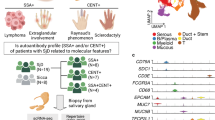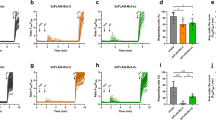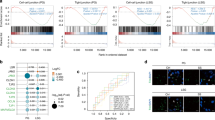Abstract
Salivary epithelial cells from patients with primary Sjögren's syndrome (SS) undergo Fas-mediated apoptosis. Bcl-2 and Bcl-xL are apoptosis suppressing oncogenes. Very little is known about the role of these oncogene molecules in salivary epithelial cells. To investigate the possible prevention of salivary glandular destruction in SS by Bcl-2 and Bcl-xL, stable transfectants expressing these molecules were made from HSY cells, a human salivary epithelial cell line. HSY cells were transfected with an expression vector for human Bcl-2 or Bcl-xL. Stable transfectants were selected and apoptosis was induced by anti-Fas antibody. Apoptosis was quantified by propidium iodide staining followed by flow cytometry. Caspase activity was detected by immunohistochemical analysis and enzyme cleavage of DEVD-AMC, a fluorescent substrate. Response to carbachol, a muscarinic receptor agonist, and EGF was measured by Ca2+ mobilization and influx. Fas-mediated apoptosis was significantly inhibited in Bcl-2 and Bcl-xL transfectants compared to wild-type and control transfectants (empty vector). Surprisingly, caspase activity was not inhibited in Bcl-2 and Bcl-xL transfectants. Activation of the Fas pathway in the Bcl-2 and Bcl-xL transfectants by antibody also inhibited carbachol and EGF responsiveness (i.e., Ca2+ mobilization and/or influx) by 50–60%. This Fas-mediated inhibition of cell activation was partially or completely restored by specific peptide interference of caspase enzyme activity. The prevention of Fas-mediated apoptosis by the overexpression of Bcl-2 and Bcl-xL in salivary gland epithelial cells results in injured cells expressing caspase activity and unable to respond normally to receptor agonists. Such damaged cells may exist in SS patients and could explain the severe dryness out of proportion to the actual number of apoptotic cells seen on salivary gland biopsy. Cell Death and Differentiation (2000) 7, 1119–1126
Similar content being viewed by others
Log in or create a free account to read this content
Gain free access to this article, as well as selected content from this journal and more on nature.com
or
Abbreviations
- SS:
-
Sjögren's syndrome
- FasL:
-
Fas ligand
- EGF:
-
epidermal growth factor
References
Itoh N, Yonehara S, Ishii A, Yonehara M, Mizushima SI, Sameshima M, Hase A, Seto Y and Nagata S . 1991 The polypeptide encoded by the cDNA for human cell surface antigen fas can mediate apoptosis. Cell 66: 233–243
Oehm A, Behrmann I, Falk W, Pawlita M, Maier G, Klas C, Li-Weber M, Richards S, Dheim J, Trauth BC, Ponsting H and Krammer PH . 1992 Purification and molecular cloning of the APO-1 cell surface antigen, a member of the tumor necrosis factor/nerve growth factor receptor superfamily. J. Biol. Chem. 267: 10709–10715
Nagata S and Golstein P . 1995 The Fas death factor. Science 267: 1449–1456
Enari M, Hug H and Nagata S . 1995 Involvement of an ICE-like protease in Fas-mediated apoptosis. Nature 375: 78–81
Cifone MG, Roncaioli P, De Maria R, Camarda G, Santoni A, Ruberti G and Testi R . 1995 Multiple pathways originate at the Fas/APO-1 (CD95) receptor: sequential involvement of phosphatidylcholine-specific phospholipase C and acidic sphingomyelinase in the propagation of the apoptotic signal. EMBO J. 14: 5859–5868
Los M, Van de Craen M, Penning LC, Schenk H, Westendorp M, Baeuerle PA, Dröge W, Krammer PH, Fiers W and Schulze-Osthoff K . 1995 Requirement of an ICE/CED-3 protease for Fas/APO-1-mediated apoptosis. Nature 375: 81–83
Scaffidi CS, Fulda S, Srinivasan A, Friesen C, Li F, Tomaselli KJ, Debatin K-M, Krammer PH and Peter ME . 1998 Two CD995 (APO-1/Fas) signaling pathways. EMBO J. 17: 1675–1687
Gill BM, Nishikata H, Chan G, Delovitch TL and Ochi A . 1994 Fas antigen and sphingomyelin-ceramide turnover-mediated signaling: role in life and death of T lymphocytes. Immunol. Rev. 142: 113–145
Cifone MG, De Maria R, Roncaioli P, Rippo MR, Azuma M, Lanier LL, Santoni A and Testi R . 1994 Apoptotic signaling through CD95 (Fas/Apo-1) activates an acidic sphingomyelinase. J. Exp. Med. 180: 1547–1552
Boise LH, Gonzalez-Gracia M, Postema CE, Ding L, Lindsten T, Turka LA, Mao X, Nuñez G and Thompson CB . 1993 bcl-x, a bcl-2-related gene that functions as a dominant regulator of apoptotic cell death. Cell 74: 597–608
Wilson SE, Li Q, Weng J, Barry-Lane PA, Jester JV, Liang Q and Wordinger RJ . 1996 The Fas-Fas ligand system and other modulators of apoptosis in the cornea. Invest. Ophthalmol. Vis. Sci. 37: 1582–1592
Galle PR, Hofmann WJ, Walczak H, Schaller H, Otto G, Stremmel W, Krammer PH and Runkel L . 1995 Involvement of the CD95 (APO-1/Fas) receptor and ligand in liver damage. J. Exp. Med. 182: 1223–1230
Giordano C, Stassi G, D Maria R, Todaro M, Richiusa P, Papoff G, Ruberti G, Bagnasco M, Testi R and Galluzzo A . 1997 Potential involvement of Fas and its ligand in the pathogenesis of Hashimoto's thyroiditis. Science 275: 960–963
Kondo T, Suda T, Fukuyama H, Adachi M and Nagata S . 1997 Essential roles of the Fas ligand in the development of hepatitis. Nat. Med. 9: 409–413
Schelling JR, Nkemere N, Kopp J and Cleveland RP . 1998 Fas-dependent fratricidal apoptosis is a mechanism of tubular epithelial cell deletion in chronic renal failure. Lab. Invest. 78: 813–824
Kong L, Ogawa N, Nakabayashi T, Liu GT, D'Souza E, McGuff HS, Guerrero D, Talal N and Dang H . 1997 Fas and Fas ligand expression in salivary glands of patients with primary Sjögren's syndrome. Arthritis Rheum. 39: 87–97
Nakajima T, Aono H, Hasunuma T, Yamamoto K, Shirai T, Hirohata K and Nishioka K . 1995 Apoptosis and functional Fas antigen in rheumatoid arthritis synoviocytes. Arthritis Rheum. 38: 485–491
Dowling P, Shang G, Raval S, Menonna J, Cook S and Husar W . 1996 Involvement of the CD95 (APO-1/Fas) receptor/ligand system in multiple sclerosis brain. J. Exp. Med. 184: 1513–1518
De Maria R and Testi R . 1998 Fas-FasL interactions: a common pathogenetic mechanism in organ-specific autoimmunity. Immunol. Today 19: 121–125
Green DR and Reed JC . 1998 Mitochondria and apoptosis. Science 281: 1309–1312
Oltvai ZN and Korsmeyer SJ . 1994 Checkpoints of dueling dimers foil death wishes. Cell 79: 189–192
Wang K, Yin XM, Chao DT, Milliman CL and Korsmeyer SJ . 1996 BID: a novel BH3 domain-only death agonist. Genes Dev. 10: 2859–2869
Casciola-Rosen LA, Anhalt G and Rosen A . 1994 Autoantigens targeted in systemic lupus erythematosus are clustered in two populations of surface structures on apoptotic keratinocytes. J. Exp. Med. 179: 1317–1330
Tan EM . 1994 Autoimmunity and apoptosis. J. Exp. Med. 179: 1083–1086
Casciola-Rosen L, Rosen A, Petri M and Schlissel M . 1996 Surface blebs on apoptotic cells are sites of enhanced procoagulant activity: implications for coagulation events and antigenic spread in systemic lupus erythemeatosus. Proc. Natl. Acad. Sci. USA 93: 1624–1629
Pittoni V and Isenberg D . 1998 Apoptosis and antiphospholipid antibodies. Semin. Arthritis Rheum. 28: 163–178
Kong L, Robinson CP, Peck AB, Vela-Roch N, Sakata KM, Dang H, Talal N and Humphreys-Beher MG . 1998 Inappropriate apoptosis of salivary and lacrimal gland epithelium of immunodeficient NOD-scid mice. Clin. Exp. Rheumatol. 16: 675–681
Ji L, Ito M, Zhang G, Hirabayashhi Y, Inokuchi J and Yamagata T . 1998 Effects of endoglycoceramidase of D-threo-1-phenyl-2-decanoylamino-3 morpholino-1-propanol on glucose uptake, glycolysis, and mitochondrial respiration in HL60 cells. Arch. Biochem. Biophys. 359: 107–114
Yang X, Khosravi-Far R, Chang HY and Baltimore D . 1997 Daxx, a novel Fas-binding protein that activates JNK and apoptosis. Cell 89: 1067–1076
Berridge MV, Tan AS, McCoy KD, Kansara M and Rudert F . 1996 CD95 (Fas/Apo-1)-induced apoptosis results in loss of glucose transporter function. J. Immunol. 156: 4092–4099
Sainio-Pollanen S, Erkkila S, Alanko S, Hanninen A, Pollanen P and Simell O . 1998 The role of Fas ligand in the development of insulitis in nonobese diabetic mice. Pancreas 16: 154–159
Martin SJ and Green DR . 1995 Protease activation during apoptosis: death by a thousand cuts. Cell 82: 349–352
Kovacs B and Tsokos GC . 1995 Cross-linking of the Fas/Apo-1 antigen suppresses the CD3-mediated signal transduction events in human T lymphocytes. J. Immunol. 155: 5543–5549
Kong L, Ogawa N, McGuff HS, Nakabayashi T, Sakata K-M, Masago R, Vela-Roch N, Talal N and Dang H . 1998 Bcl-2 family expression in salivary glands from patients with primary Sjögren's syndrome: involvement of bax in salivary gland destruction. Clin. Immunol. Immunopathol. 88: 133–141
Paardekooper GM, Cammelli S, Zeilstra LJ, Coppes RP and Konings AW . 1998 Radiation-induced apoptosis in relation to acute impairment of rat salivary gland function. Int. J. Radiat. Biol. 73: 641–648
Hoth M, Fanger CM and Lewis RS . 1997 Mitochondrial regulation of store operated calcium signaling in T lymphocytes. J. Cell. Biol. 137: 633–648
Susin SA, Zamzami N, Castedo M, Hirsch T, Marchetti P, Macho A, Daugas E, Geusken M and Kroemer G . 1996 Bcl-2 inhibits the mitochondrial release of an apoptogenic protease. J. Exp. Med. 184: 1331–1341
Boise LH and Thompson CB . 1997 Bcl-x(L) can inhibit apoptosis in cells that have undergone Fas-induced protease activation. Proc. Natl. Acad. Sci. USA 94: 3759–3764
Miossec C, Dutilleul V, Fassey F and Diu-Hercend A . 1997 Evidence for CPP32 activation in the absence of apoptosis during T lymphocyte stimulation. J. Biol. Chem. 272: 13459–13462
Wilhelm S, Wagner H and Häcker G . 1998 Activation of caspase-3-like enzymes in non-apoptotic T cells. Eur. J. Immunol. 28: 891–900
Kennedy NJ, Kataoka T, Tschopp J and Budd RC . 1999 Caspase activation is required for T cell proliferation. J. Exp. Med. 190: 1891–1896
Puney Jr JW . 1986 Identification of cellular activation mechanism associated with salivary secretion. Annu. Rev. Physiol. 48: 75–88
Ambudkar IS, Hiramatsu Y, Lockwich T and Baum BJ . 1993 Activation and regulation of calcium entry in rat parotid gland acinar cells. Crit. Rev. Oral Biol. Med. 4: 421–425
Teitebaum I . 1990 The epidermal growth factor receptor is coupled to a phospholipase A2-specific pertussis toxin-inhibitable guanine nucleotide-binding regulatory protein in cultured rat inner medillary collecting tubule cells. J. Biol. Chem. 265: 4218–4222
Pai R and Tarnawski A . 1998 Signal transduction cascades triggered by EGF receptor activation: relevance to gastric injury repair and ulcer healing. Dig. Dis. Sci. 43: 14S–22S
King P and Goodburn S . 1998 STAT1 is inactivated by a caspase. J. Biol. Chem. 273: 8699–8794
Ravi R, Bedi A, Fuchs EJ and Bedi A . 1998 CD95 (Fas)-induced caspase-mediated proteolysis of NF-kappaB. Cancer Res. 58: 882–886
Scheving LA, Jin W-H, Chong K-M, Gardner W and Cope FO . 1998 Dying enterocytes downregulate signaling pathways converging on Ras: rescue by protease inhibition. Am. J. Physiol. 274: C1363–C1372
France-Lanord V, Brugg B, Michel PP, Agid Y and Ruberg M . 1997 Mitochondrial free radical signal in ceramide-dependent apoptosis: a putative mechanism for neuronal death in Parkinson's disease. J. Neurochem. 69: 1612–1621
Patton L, Pollack S and Wellner R . 1991 Responsiveness of a human parotid epithelial cell line (HSY) to autonomic stimulation: muscarinic control of K+ transport. In vitro Cell. Dev. Biol. 27A: 779–785
Nicoletti I, Migliorati G, Pagliacci MC, Grigani F and Riccardi C . 1991 A rapid and simple method for measuring thymocyte apoptosis by propidium iodide staining and flow cytometry. J. Immunol. Methods. 139: 271–279
Olsen JG, Salih MA, Harrison JL, Herrera I, Luther MF, Kalu DN, Lifschitz MD, Katz MS and Yeh C-K . 1997 Modulation by food restriction of intracellular calcium signaling in parotid acinar cells of aging Fischer 344 rats. J. Gerontol. 52A: B152–B158
Vandenberghe PA and Ceuppens JL . 1990 Flow cytometric measurement of cytoplasmic free calcium in human peripheral blood T lymphocytes with fluo-3, a new fluorescent calcium indicator. J. Immunol. Methods. 127: 197
Acknowledgements
The authors are grateful to Drs. Rudin and Lee for their advice and help in establishing stable transfectants; and Charles Thomas for flow cytometric analysis. Support for this work was provided by grants from the RGK Foundation (Austin, TX) and National Institute of Dental and Craniofacial Research (DE10863 and DE12203 to H Dang; DE90270 to GH Zhang; DE12188 to C-K Yeh).
Author information
Authors and Affiliations
Corresponding author
Additional information
Edited by JC Reed
Rights and permissions
About this article
Cite this article
Liu, XB., Masago, R., Kong, L. et al. G-protein signaling abnormalities mediated by CD95 in salivary epithelial cells. Cell Death Differ 7, 1119–1126 (2000). https://doi.org/10.1038/sj.cdd.4400745
Received:
Revised:
Accepted:
Published:
Issue date:
DOI: https://doi.org/10.1038/sj.cdd.4400745
Keywords
This article is cited by
-
Cholinergic receptor pathways involved in apoptosis, cell proliferation and neuronal differentiation
Cell Communication and Signaling (2009)



